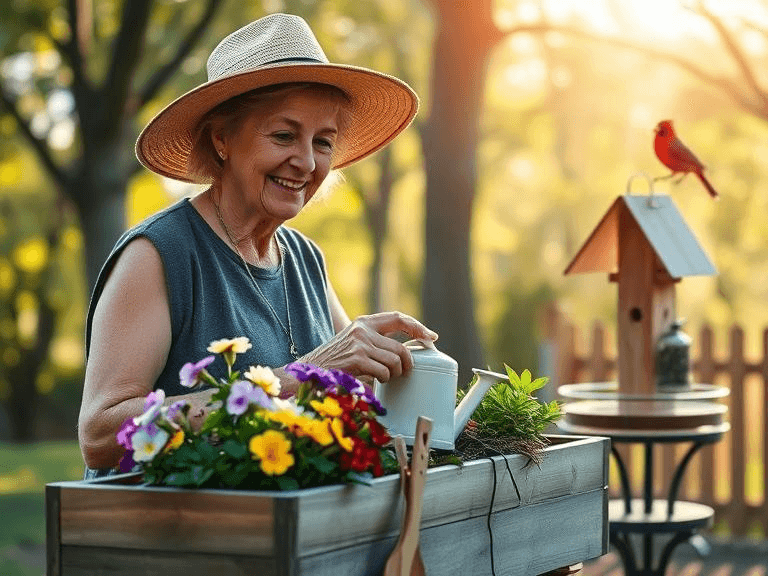When the first tender shoots push through the soil and birds return with their cheerful songs, something magical happens to our spirits. For seniors especially, spring gardening offers a beautiful way to reconnect with nature after winter’s long rest. As someone who has guided countless older adults through their gardening journeys, I’ve witnessed firsthand how tending to plants can breathe new life into daily routines, regardless of mobility challenges or gardening experience.
“The day I rediscovered gardening at 75 was the day I found purpose again,” Martha, an 81-year-old client of mine once shared as we planted pansies together. “There’s something deeply satisfying about nurturing something and watching it grow.”
This spring, whether you’re an experienced gardener looking to adapt your hobby to changing abilities or someone seeking a new pastime entirely, the garden welcomes you with endless possibilities. The activities outlined here are specifically designed to accommodate various energy levels and physical capabilities while maximizing the joy and benefits that gardening brings.
Benefits That Bloom Beyond the Garden
The rewards of gardening extend far beyond the visible results of colorful blooms and fresh produce. For seniors, these benefits can be particularly transformative across multiple dimensions of health and wellbeing.
Physically, gardening serves as a gentle yet effective form of exercise that improves strength, flexibility, and cardiovascular health without the intensity of traditional workouts. Tasks like reaching for plants, bending slightly to tend to containers, and walking between garden spots improve circulation and maintain joint mobility. Research from the Centers for Disease Control indicates that just 30 minutes of moderate-intensity gardening activities can burn approximately 170-200 calories for someone weighing 150-180 pounds – a significant contribution to maintaining a healthy weight and muscle tone.
The mental health benefits are equally compelling. Dr. Elena Rothenberg, a geriatric psychiatrist I consulted for this article, explains: “Gardening places seniors in a mindful state where they focus on the present moment – feeling the soil, observing growth, experiencing sensory stimulation. This natural mindfulness significantly reduces symptoms of anxiety and depression while improving cognitive function.” The sense of achievement that comes from nurturing plants from seed to bloom also fosters self-efficacy and purpose, particularly important for those transitioning through retirement or other major life changes.
Perhaps most overlooked is gardening’s social dimension. Community garden plots, plant exchanges with neighbors, or simply having family members assist with certain tasks creates natural opportunities for meaningful interaction. As one senior gardener from Vermont told me, “My garden club meetings have become the highlight of my month. We share not just plants, but stories, advice, and friendship.”
Spring Gardening Activities Tailored for Seniors
Planting Easy-to-Grow Flowers and Herbs
Starting with plants that provide high reward for minimal effort creates immediate satisfaction while building confidence. When I work with seniors new to gardening or those adapting to physical limitations, I always begin with these forgiving favorites.
Marigolds rank among the most reliable choices for senior gardeners. These cheerful orange and yellow blooms require little more than well-drained soil and a sunny location to thrive throughout the season. Their pest-repelling properties make them practical companions for vegetable containers, and their continuous blooming with minimal deadheading provides ongoing visual rewards. To plant marigolds successfully, simply prepare containers with quality potting soil, plant seeds just below the surface or transplant nursery seedlings, and water thoroughly. After establishment, checking soil moisture every few days is typically sufficient – when the top inch feels dry to the touch, it’s time to water.
Pansies bring early color to spring gardens with their delightful “faces” and impressive cold tolerance. Margaret, a 79-year-old garden enthusiast I’ve worked with, describes them as “the first smile of spring.” These flowers perform beautifully in partial shade to full sun and maintain their blooms longer with regular deadheading – a perfect fine-motor activity for seniors. For best results, plant pansies in rich, well-draining soil that stays consistently moist but never soggy. Their compact growth makes them ideal for window boxes and porch containers where they can be easily admired up close.
On the edible side, basil offers aromatic pleasure along with culinary usefulness. Growing basil in pots near kitchen windows or on patios provides easy access for cooking while filling the air with its distinctive fragrance. The plant’s repeated harvesting needs – pinching leaves to encourage bushier growth – creates ongoing interaction without demanding strenuous effort. Start with a large container (at least 8 inches deep) filled with nutrient-rich potting mix, place in a location receiving 6-8 hours of sunlight, and water when the top layer of soil begins to dry. The visual transformation after each harvesting session provides tangible proof of the gardener’s impact.
For seniors with arthritic conditions or balance concerns, raised planters at waist or wheelchair height eliminate the need for bending or kneeling. Local handyman services can often construct custom-height raised beds, though commercial options are increasingly available. Alternatively, repurposing household items like old dressers with drawers pulled out at different lengths creates an eclectic, accessible tiered garden that showcases personality alongside plants.
Tending to Spring Bulbs
For seniors who planted bulbs in fall or who have established perennial beds, spring brings the rewarding task of nurturing these early bloomers. The minimal maintenance required makes bulb gardens particularly suitable for those with limited energy or mobility.
Tulips, with their elegant shape and vibrant color range, require only basic care once established. Good drainage remains their primary requirement, as standing water quickly leads to bulb rot. Light watering during dry spells and removing spent flowers prevents energy waste on seed production, directing it instead to bulb strength for next year’s display. For seniors who find bending difficult, specialized bulb planters with long handles make fall planting easier, while spring maintenance can be managed with lightweight extended-reach tools.
Daffodils epitomize low-maintenance gardening joy. Their cheerful yellow and white blooms arrive early in the season and require almost no intervention to thrive year after year. Perhaps most importantly, their natural resistance to deer, rabbits, and squirrels means seniors won’t find their hard work destroyed overnight. After blooming, allow foliage to yellow naturally before removing it – this period of photosynthesis strengthens bulbs for future seasons. As Diana, an 85-year-old gardener from Michigan shared: “My daffodils have outlasted three different houses and two husbands. They return faithfully every spring with almost no attention from me.”
Hyacinths bring intoxicating fragrance to spring gardens, making them perfect for planting near seating areas where their scent can be fully appreciated. Their sturdy stems generally stand upright without support, though occasional staking might be necessary in windy locations. Moist but well-draining soil in partial sun positions keeps these fragrant blooms happy with minimal intervention required from gardeners. Their distinctive appearance and heady scent provide sensory stimulation particularly beneficial for seniors with dementia or memory challenges.
For those with limited outdoor space, forcing bulbs indoors extends the joys of spring gardening regardless of weather conditions or mobility. Pre-chilled bulbs placed in decorative containers with pebbles and water create indoor displays that bring nature’s renewal right to the windowsill or dining table. This activity works beautifully for seniors in assisted living facilities or apartments without balcony access.
Creating a Small Container Garden
Container vegetable gardening offers the satisfaction of growing food without the physical demands of traditional garden plots. Even a small collection of pots on a patio or balcony can yield impressive harvests while providing gentle, purposeful activity.
Lettuce varieties thrive in shallow containers and provide almost immediate gratification with their quick growth. Mesclun mixes and loose-leaf varieties allow for cut-and-come-again harvesting, where older outer leaves are collected while the plant continues producing new growth from the center. This creates ongoing interaction and regular, small harvests perfect for single seniors or those with limited refrigerator space. For best results, sow seeds in containers at least 6 inches deep filled with moisture-retentive potting mix, place in morning sun/afternoon shade positions, and keep soil consistently moist but not waterlogged.
Radishes deserve special mention for senior gardeners due to their remarkably quick growth cycle. From seed to harvest in just 3-4 weeks, they provide nearly immediate success and encouragement. Their ability to grow in containers as shallow as 6 inches makes them suitable for even the smallest spaces. Plant seeds directly in loose soil about half an inch deep and one inch apart, thin to two inches once seedlings emerge, and maintain consistent moisture. The satisfaction of pulling these crisp, peppery vegetables after such a short waiting period creates confidence that can inspire expanded gardening efforts.
Cherry tomatoes in hanging baskets bring the garden up to eye level while eliminating stooping or bending. Varieties like ‘Tumbling Tom’ or ‘Basket King’ cascade beautifully from containers and produce abundant sweet fruits within easy reach. Start with established seedlings rather than seeds for quicker results, plant in containers at least 12 inches deep filled with premium potting mix, and place in the sunniest available location. A slow-release fertilizer at planting time reduces maintenance needs through the season.
For seniors managing conditions like diabetes, herb containers near the kitchen door provide fresh flavors that enhance meals without adding sodium or calories. Mint, thyme, and rosemary all thrive in containers and stimulate appetite through their aromatics – particularly beneficial for seniors experiencing decreased interest in food. These perennial herbs require minimal care beyond occasional watering and light pruning, providing ongoing benefits for minimal effort.
Nature Observation and Mindful Moments
Some of the most rewarding garden activities involve simply being present and observant in outdoor spaces. Creating dedicated areas for passive enjoyment ensures that seniors can connect with nature even on days when energy or mobility is limited.
Setting up a comfortable seating area with an unobstructed view of bird feeders provides entertainment and connection to wildlife with zero physical demands. Position a weather-resistant chair or bench in a shaded or partially shaded location, add a small side table for binoculars or refreshments, and place feeders within clear view but far enough from the seating to attract cautious birds. Different feeder types attract different species – tube feeders for finches, platform feeders for cardinals and jays, suet cages for woodpeckers – creating a diverse avian community to observe.
Keeping a simple garden journal builds cognitive engagement alongside gardening activities. Rather than elaborate record-keeping that might feel burdensome, encourage simple observations: the date the first robin appeared, when certain flowers bloomed, or notable weather patterns. This practice not only supports memory function but creates a valuable reference for future seasons. As William, a 77-year-old master gardener told me, “My garden journal helps me remember not just what happened in my garden, but what was happening in my life at those moments. It’s become an unexpected memoir.”
Creating sensory stations throughout the garden provides stimulation even for seniors with significant cognitive or physical challenges. Wind chimes, textured plants like lamb’s ear, fragrant herbs placed at nose level, and brightly colored flowers engage multiple senses simultaneously. For grandparents, these sensory elements create perfect exploration opportunities with young grandchildren, fostering intergenerational connection through shared discovery.
Adapting Activities for Comfort and Safety
With thoughtful adaptations, gardening can remain accessible regardless of changing physical abilities. The key lies in modifying approaches rather than abandoning beloved activities.
Ergonomic tools have revolutionized gardening accessibility for seniors. Lightweight aluminum tools reduce strain, while extended handles eliminate bending. Grip adaptations like foam tubing slipped over standard handles make tools usable for those with arthritis or weakened grip strength. Garden supply companies increasingly offer specialized adaptive tools, but simple modifications to existing equipment can be equally effective. Attaching a broomstick to a hand trowel with sturdy tape, for instance, creates an extended-reach tool at minimal cost.
Timing gardening sessions strategically prevents overtaxing and associated injuries. Morning hours, when temperatures remain moderate and energy levels are typically highest, provide optimal conditions for most seniors. Breaking activities into 15-30 minute sessions with built-in rest periods maintains enjoyment while preventing fatigue. As Clara, an 80-year-old gardener with rheumatoid arthritis explains, “I’ve learned to garden by the timer, not by the task. When my phone chimes after 20 minutes, I take a break regardless of whether I’ve finished what I’m doing. The garden will still be there tomorrow, but I need to protect my joints today.”
Creating partnerships for physically demanding tasks preserves independence where it matters most. While seniors might need assistance with heavy lifting or extensive digging, maintaining decision-making authority over plant selection and placement preserves the essential creativity and self-expression that makes gardening meaningful. Garden clubs often create buddy systems where members assist each other with different aspects of garden maintenance based on their varying abilities. Multi-generational family gardening days can accomplish major seasonal tasks while creating meaningful shared experiences.
For those using wheelchairs or walkers, garden path modifications ensure continued access to beloved spaces. Paths should be at least 36 inches wide with firm, level surfaces free from trip hazards like exposed roots or uneven paving stones. Strategic rest points with seating placed every 25-30 feet allow for recovery during garden tours. Vertical gardening techniques using trellises, wall-mounted planters, and shepherd’s hooks bring plants to accessible heights while adding architectural interest to garden spaces.
Nursery Schedule for Spring
Planning nursery visits strategically throughout spring ensures seniors find what they need without facing overwhelming crowds or sold-out inventory. This timeline helps coordinate gardening activities with product availability.
Early Spring (March-April)
The first nursery visit of the season should focus on cool-season plants and planning supplies. During this period, look for pansies, violas, and primroses for immediate color, along with seed packets for early vegetables like lettuce, spinach, and radishes. This is also the ideal time to purchase specialized potting soils, particularly those formulated for containers or raised beds, before supplies dwindle in peak season.
Phone ahead to confirm operating hours, as many nurseries maintain limited schedules early in the season. Ask specifically about senior shopping hours – many garden centers now offer special time slots with reduced crowds and extra staff assistance for older customers, typically during weekday mornings. These dedicated hours provide calmer shopping experiences with additional help available for loading purchases or reaching high shelves.
If starting seeds indoors, early spring nursery visits should include gathering supplies like seed-starting trays, germination mix, and plant labels. Select varieties specifically labeled as container-appropriate if planning patio gardens, as these have been bred for compact growth habits and improved performance in confined spaces.
Mid-Spring (April-May)
As temperatures stabilize, mid-spring nursery visits should focus on warm-season plants and perennials. This represents prime shopping time for heat-loving annuals like marigolds and petunias, herb plants including basil and parsley, and vegetable seedlings such as tomatoes and peppers. Garden centers reach peak inventory during this period but also experience their heaviest customer traffic.
For seniors who find crowded shopping environments challenging, weekday visits near opening time provide the best combination of good selection and manageable crowd levels. Alternatively, many nurseries now offer online ordering with curbside pickup options, allowing pre-selection of specific plants without navigating busy retail spaces.
Mid-spring represents the ideal window for purchasing ergonomic tools and adaptive gardening equipment, as these specialized items often sell out as the season progresses. Look for lightweight watering cans with balanced handles, kneeling benches with support handles for rising, and tools specifically designed for one-handed use or weakened grip strength.
Late Spring (May-June)
Final nursery visits of spring should address any garden gaps and focus on summer preparation. This period offers discounted prices on remaining spring inventory alongside newly arrived heat-tolerant summer selections. Items to consider include decorative containers (often available at clearance prices), quality garden hats with good sun protection, and slow-release fertilizers that reduce the frequency of feeding throughout summer months.
Late spring also brings increased availability of larger specimen plants like flowering shrubs and ornamental trees, which garden centers often delay stocking until danger of frost has passed. These substantial plants create garden impact with minimal planting effort, making them excellent choices for seniors establishing new garden areas with limited energy for multiple plantings.
If summer heat limits gardening activity in your region, late spring nursey visits should include supplies for garden maintenance during reduced activity periods. Mulch to suppress weeds and conserve moisture, automatic watering systems with timers, and protective shade cloths allow gardens to thrive with minimal intervention during the hottest months.
Throughout the spring season, inquire about delivery services for heavier items like soil bags, large containers, or bulky equipment. Many local nurseries offer free or low-cost delivery for seniors within reasonable distances, eliminating transportation challenges for those without suitable vehicles or lifting capability.
Embracing the Garden Journey
As spring unfolds its promises across the landscape, remember that gardening success isn’t measured by perfection but by participation. The true value lies not in flawless blooms or abundant harvests, but in the moments of connection, purpose, and joy experienced along the way.
Start with a single container of favorite flowers or herbs rather than attempting complete garden transformations. Use the nursery schedule to guide your activities without creating pressure to accomplish everything at once. Most importantly, allow yourself permission to adapt both expectations and methods as needed. As Grace, a 92-year-old gardener who transitioned from managing acres to tending windowsill pots, wisely noted: “The size of my garden has shrunk, but my appreciation for every bloom has grown immeasurably.”
I encourage you to try just one activity from this guide in the coming weeks. Perhaps place a bird feeder where you can observe it during morning coffee, plant a single container of colorful pansies, or simply sit quietly in a garden space noting the subtle changes that spring brings. Whatever you choose, approach it not as a task to complete but as an opportunity to participate in nature’s most hopeful season.
What garden memories bring you joy? Which spring activity might you incorporate this season? The garden welcomes gardeners of all abilities with equal generosity, offering its lessons and pleasures to anyone willing to participate in its rhythms.





